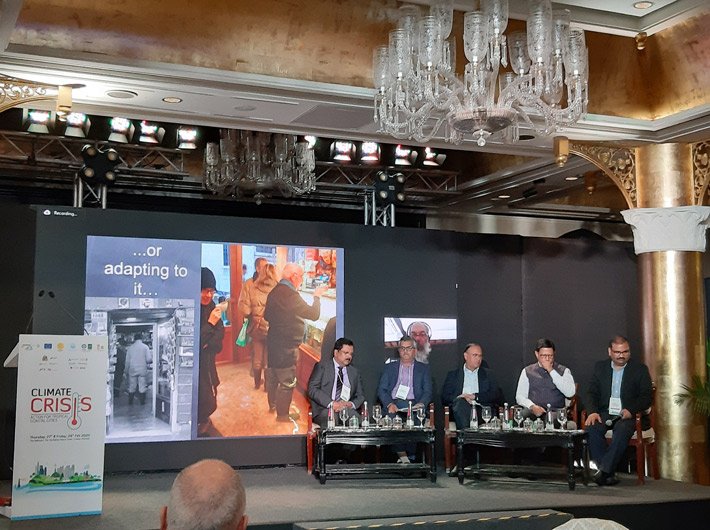Infrastructure development, reducing carbon emissions, disaster handling key concerns
At a conclave titled ‘Climate Crisis - Action for Tropical Coastal Cities’, organized by Mumbai First last week, stakeholders came together for two days to discuss risk management in coastal cities, urban flooding, action plans – best practices, and policy perspectives for enabling climate adaptation among other issues.
Speaking on ‘climate change mitigation: a global perspective on transport, land use and governance’, R A Rajeev, metropolitan commissioner, MMRDA, said that Mumbai’s transport share has reduced from 75% to 65% now. Since independence, the city has not increased the capacity of its suburban train system or BEST buses. While the public transport capacity did not increase population increased and they brought private cars which led to congestion on city roads.
Rajeev said that unlike in any other city in the world, they are simultaneously building 200 km of metro lines at a time. “Mumbai has plans for 337 km metro lines by 2025-26. This year we will be commissioning almost 35 km of metro line and thereafter every year one line will be commissioned and completed by 2025-26. If these metro systems come up as planned, we will be able to more than double the capacity of public transport in city.” He added that for last mile connectivity they are working with motorized transport like share taxis and buses and non-motorized transport like e-scooters and cycles. All this will reduce traffic congestion from 75% to almost 9%-10% in the city, fuel consumption will reduce by almost 30% and air pollution will reduce by 58% -60%. He also said that most metro components are also green by nature.
Acknowledging lack of coordination among agencies, the metropolitan commissioner said that with utility maps being not made available they are consumers of bad information from the point of view of infrastructure development. He also recalled that earlier while handling BRIMS TOWAD they realized that the BMC did not have original maps of underground drains constructed during the British period which were lying in a museum in London.
In his video address, Dr Phillip Rode, LSE Cities, spoke on climate change and its mitigation. He said that denser cities are more efficient, have lesser carbon emissions which come from transport and can build energy efficiency. “Compact cities are a fantastic source of efficiency,” said Rode. The problem is that globally we are seeing a massive horizontal expansion of our cities and massive land grab of urban environment. “The current predictions are that from 2000-30 there will be threefold increase over the land while the population is only increasing in these urban areas by a factor of 1.5. So we are losing out of efficacies of density.”
Rode said that as part of a gradual long-term mitigation agenda cities are embracing transit oriented development. Citing examples, he said the city of London added new buildings for both living and working at central locations and public transport. “Indian cities are traditionally fantastically mixed used and its huge advantage,” he said.
Transport, he said, generates massive increases in carbon emissions, and is the hardest to crack. Cities are increasing integrating the transport function with overall accessibility function. He added that all signature reports around sustainable development no longer consider environmental issues separate from economic and social issues.
Rode said that governance arrangement in London before 2000 was a mess. It was fragmented across the national, regional and local authorities and divided into different sectors. But after the reforms, London has a very good metropolitan transport authority which brings together all forms of travel including non-motorized transport and reports directly to the mayor. It is taken care of by one institution working in cooperation with the land use planning.
“It is important to devolve responsibilities to metropolitan government, to have development around urban places rather than sectors, have multi-sectoral delivery agencies and task-forces working for you and alternatively work within an integrated strategy.” Rode also said that it is equally important to impart multi-criteria assessments that in some ways don’t prioritize one big metric like GDP over other methodologies, and use new communication technologies to bring people together in capacity building.
At another panel discussion, Sanjay Bhatia, chairman, Mumbai Port Trust, spoke on flexible and agile planning process for adaption in cities. He said that 253 hectares from Mumbai Port Trust are being completely redeveloped, out of which 60 hectares will be for high-rises and development. The remaining area of around 200 hectares will be open spaces and gardens. Bhatia said that the port side has been planned keeping in view a sea level rise of 6-7 metres. He also added that they are developing a lake within a garden which will be a reservoir during floods or they will take the water outside into the sea in the eventuality of sea level rising above one metre. Bhatia said that since they are developing water transport systems on the eastern side there will be enough boats for people in case of floods. The Mumbai Trans-Harbour Link the longest sea bridge is expected to be ready by 2022.
Mahesh Narvekar of Disaster Management Unit of MCGM, speaking on developing flood resilience for urban India, referred to the erratic and inconsistent rain pattern in Mumbai and how the city has developed its disaster management systems.
“The 2005 floods were an eye opener for everyone. Till then disaster management was a completely neglected area. We were operating out of a 100 sq feet room as emergency operation centre with two telephone lines in basement. Now there is a state-of-art emergency operation centre, availability of redundancy of communication system and CCTV cameras all over the city with live images. Besides the three teams of NDRF available in Mumbai, we have our own security force with specialist training given by NDRF and training all municipal staff in Mumbai numbering around 4,000. We have our Disaster Management Institute along with Mumbai University which imparts free training to last mile and specially children.”
Narvekar also said that that MCGM now has its own 60 automatic weather stations where they are pushing real-time that data on free downloadable android and iOS apps and reaching out to people through their Twitter handle. He however added that reaching slum population was a big challenge for them.
Municipal commissioner Praveen Pardeshi said that individual activism and public interest litigations have actively constrained and destroyed government resources to create infrastructure projects. “Public transport projects which require a lot of collective action by the state and the municipal corporation are blocked at every point, not for the want of funds but by too much discussion and too public interest litigation which leads to it going back and forth,” he said.
The conference was held in collaboration with the European Union and CSIR-NEERI, supported by the Maharashtra government and the union ministry of environment.

